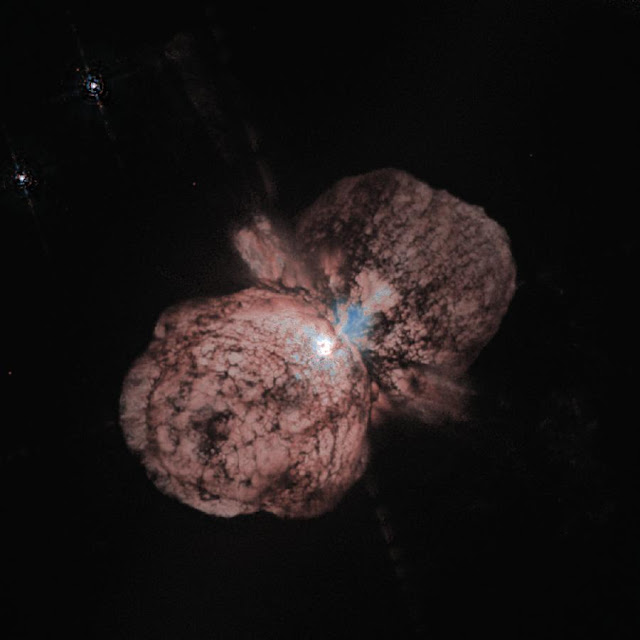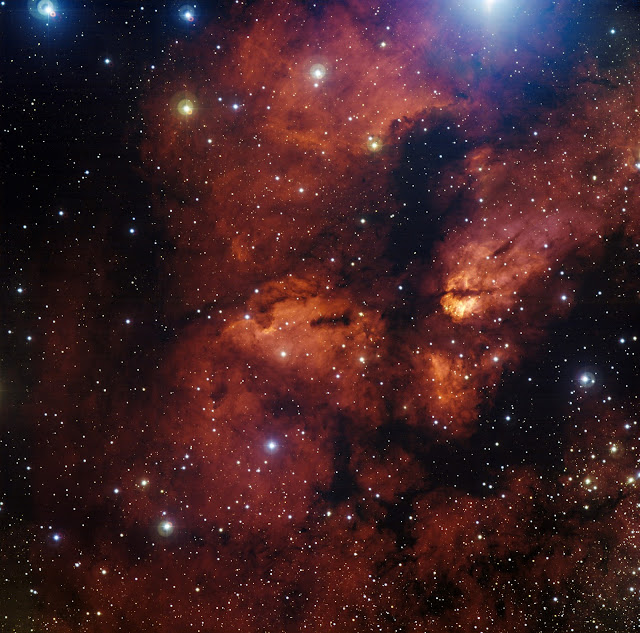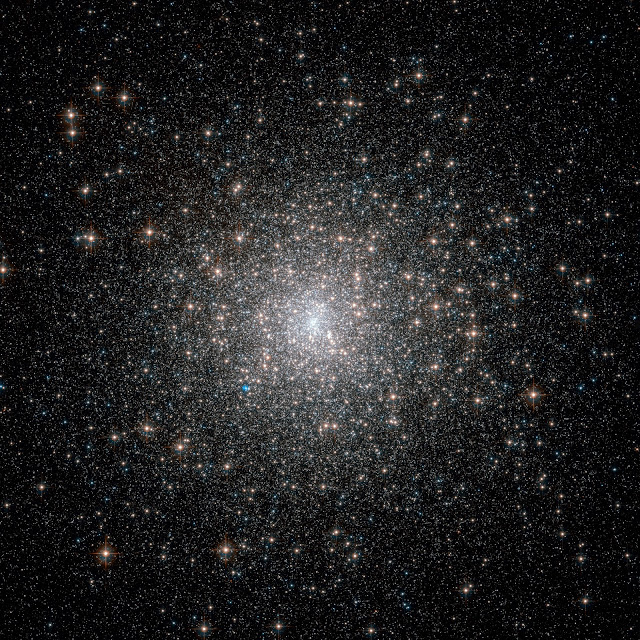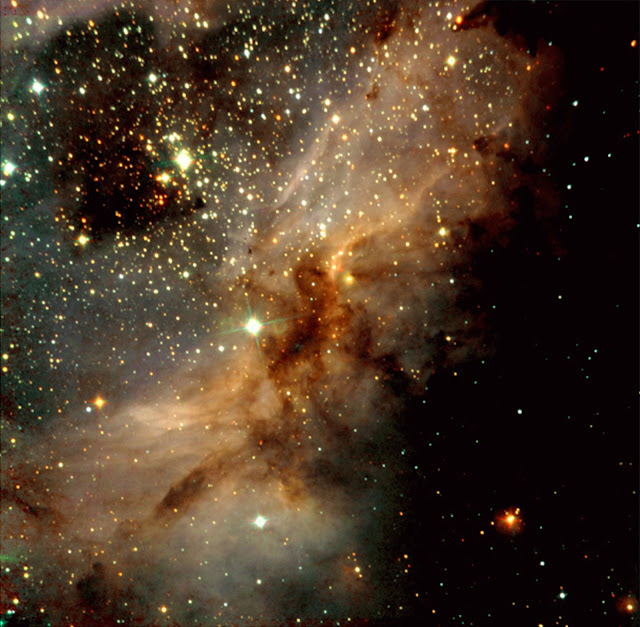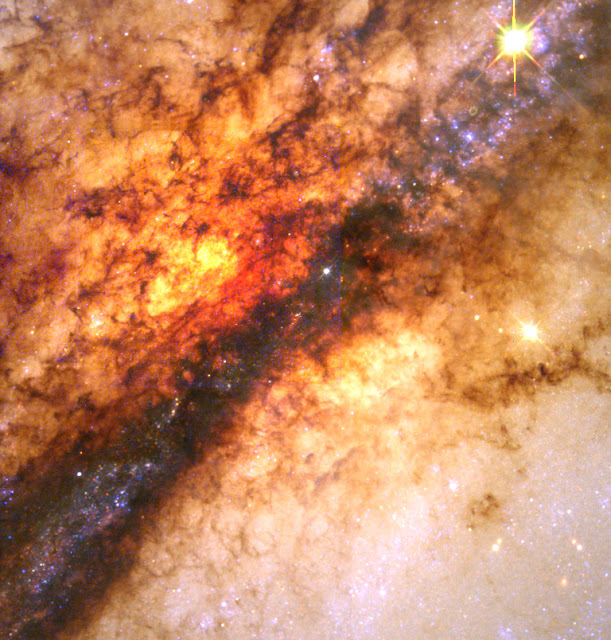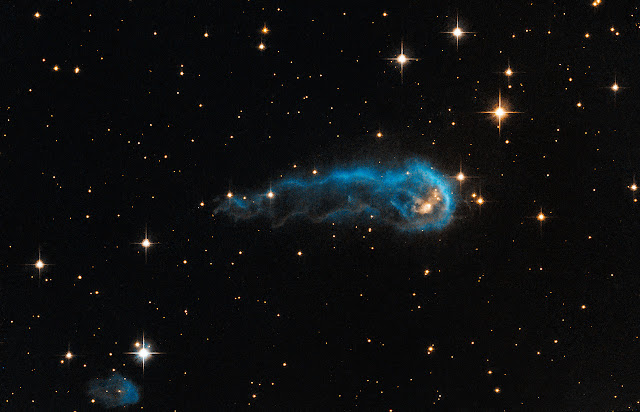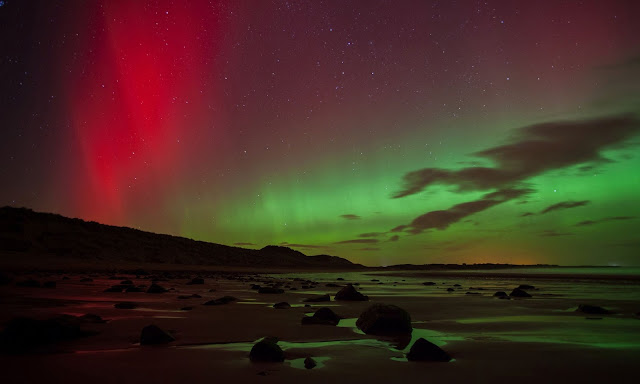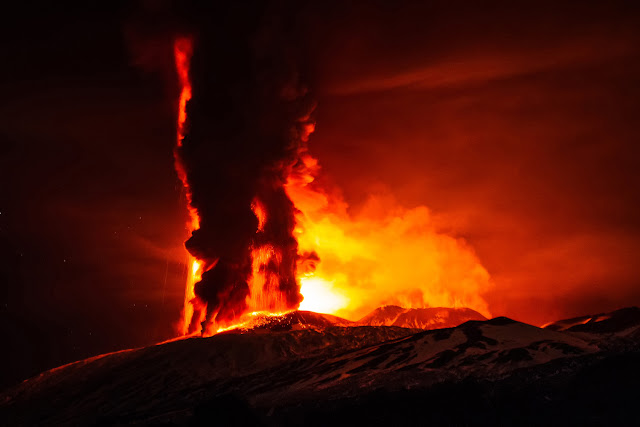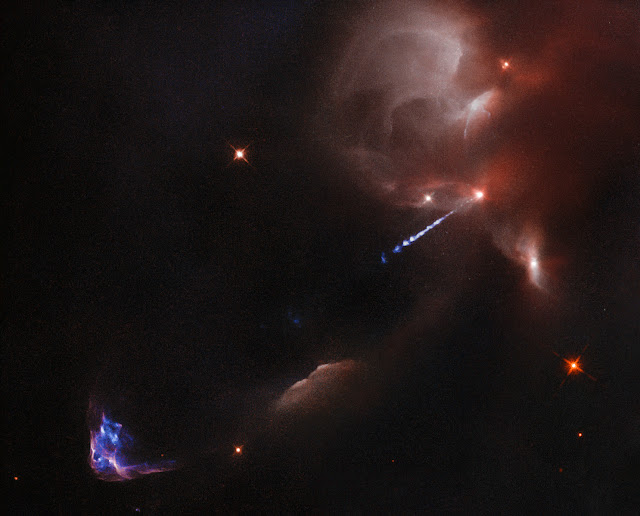Blog about Earth and Astronomy - Scientific Pictures and News about the Universe
- | Home Page |
- Best Posts
- Best Pictures
- History of the Earth
- Solar System
- Earth from Space
- ISS
- Milky Way
- Auroras
- Eclipses
- Clouds
- Lightnings
- Volcanoes
- Meteors
- Moon
- Sun
- Universe
- Nebulae
- Galaxies
- Live ISS
- Live Sun
- Aurora Forecast
- Earth Day 2018
- HD Wallpapers
- | SUBSCRIBE |
- | JOIN |
- | Send feedback |
- | Contact |
December 31, 2016
December 30, 2016
Molecular Cloud Cepheus B
- Cepheus B is a cloud of molecular hydrogen, a place where stars are known to form
- Researchers used Chandra and Spitzer to study this cloud, which is relatively close at 2,400 light years away
- The combined data reveal that massive stars may trigger star formation more often than previously thought
This composite image, combining data from the Chandra X-ray Observatory and the Spitzer Space Telescope shows the molecular cloud Cepheus B, located in our Galaxy about 2,400 light years from the Earth. A molecular cloud is a region containing cool interstellar gas and dust left over from the formation of the galaxy and mostly contains molecular hydrogen. The Spitzer data, in red, green and blue shows the molecular cloud (in the bottom part of the image) plus young stars in and around Cepheus B, and the Chandra data in violet shows the young stars in the field.
The Chandra observations allowed the astronomers to pick out young stars within and near Cepheus B, identified by their strong X-ray emission. The Spitzer data showed whether the young stars have a so-called "protoplanetary" disk around them. Such disks only exist in very young systems where planets are still forming, so their presence is an indication of the age of a star system.
These data provide an excellent opportunity to test a model for how stars form. The new study suggests that star formation in Cepheus B is mainly triggered by radiation from one bright, massive star (HD 217086) outside the molecular cloud. According to the particular model of triggered star formation that was tested -- called the radiation-driven implosion (RDI) model -- radiation from this massive star drives a compression wave into the cloud triggering star formation in the interior, while evaporating the cloud's outer layers.
The labeled version of the image (rollover the image above) shows important regions in and around Cepheus B. The "inner layer" shows the Cepheus B region itself, where the stars are mostly about one million years old and about 70-80% of them have protoplanetary disks. The "intermediate layer" shows the area immediately next to Cepheus B, where the stars are two to three million years old and about 60% of them have disks, while in the "outer layer" the stars are about three to five million years old and about 30% of them have disks. This increase in age as the stars are further away from Cepheus B is exactly what is predicted from the RDI model of triggered star formation.
Different types of triggered star formation have been observed in other environments. For example, the formation of our solar system was thought to have been triggered by a supernova explosion, In the star-forming region W5, a "collect-and-collapse" mechanism is thought to apply, where shock fronts generated by massive stars sweep up material as they progress outwards. Eventually the accumulated gas becomes dense enough to collapse and form hundreds of stars. The RDI mechanism is also thought to be responsible for the formation of dozens of stars in W5. The main cause of star formation that does not involve triggering is where a cloud of gas cools, gravity gets the upper hand, and the cloud falls in on itself.
Image Credit: X-ray (NASA/CXC/PSU/K. Getman et al.); IR (NASA/JPL-Caltech/CfA/J. Wang et al.)
Explanation from: http://chandra.harvard.edu/photo/2009/cepb/
Posted by
Earth
at
10:17 AM
1 comment:
The Expansion of Eta Carinae Debris
The massive star Eta Carinae (almost hidden in the center) underwent a giant explosion some 150 years ago. The outburst spread the material that is visible today in this very sharp Hubble image. Even though Eta Carinae is more than 8,000 light-years away, structures only 15 thousand million kilometre across (about the diameter of our solar system) can be distinguished. Dust lanes, tiny condensations, and strange radial streaks al appear with unprecedented clarity.
A huge, billowing pair of gas and dust clouds are captured in this stunning Hubble Space Telescope image of the supermassive star Eta Carinae.
Image Credit: Jon Morse (University of Colorado), and NASA/ESA
Explanation from: https://www.spacetelescope.org/images/opo9623a/
Posted by
Earth
at
10:12 AM
No comments:
Star Cluster RCW 38
The wider region surrounding the star cluster RCW 38, located about 5,500 light years away in the direction of the constellation Vela (the Sails). RCW 38 is an "embedded" cluster, in that the nascent cloud of dust and gas still envelops its stars. There, young, titanic stars bombard fledgling suns and planets with powerful winds and large amount of light, helped in their devastating task by short- lived, massive stars that explode as supernovae. In some cases, this energetic onslaught cooks away the matter that may eventually form new planetary systems. Scientists think that our own Solar System emerged from such a dramatic environment.
This image was obtained with the Wide Field Imager instrument on the MPG/ESO 2.2-metre telescope at La Silla, using data collected through four filters (B, V, R and H-alpha). The field of view is 30 arcminutes.
Image Credit: ESO
Explanation from: http://www.eso.org/public/images/eso0929c/
Posted by
Earth
at
10:09 AM
No comments:
Globular Cluster Messier 15
The dazzling stars in Messier 15 look fresh and new in this image from the NASA/Hubble Space Telescope, but they are actually all roughly 13 billion years old, making them some of the most ancient objects in the Universe.
Messier 15 is a globular cluster — a spherical conglomeration of old stars that formed together from the same cloud of gas, found in the outer reaches of the Milky Way in a region known as the halo and orbiting the Galactic Centre. This globular lies about 35 000 light-years from the Earth, in the constellation of Pegasus (The Flying Horse).
Messier 15 is one of the densest globulars known, with the vast majority of the cluster’s mass concentrated in the core. Astronomers think that particularly dense globulars, like this one, underwent a process called core collapse, in which gravitational interactions between stars led to many members of the cluster migrating towards the centre.
Messier 15 is also the first globular cluster known to harbour a planetary nebula, and it is still one of only four globulars known to do so. The planetary nebula, called Pease 1, can be seen in this image as a small blue blob to the lower left of the globular’s core.
This picture was put together from images taken with the Wide Field Channel of Hubble's Advanced Camera for Surveys. Images through yellow/orange (F606W, coloured blue) and near-infrared (F814W, coloured red) filters were combined. The total exposure times were 535 s and 615 s respectively and the field of view is 3.4 arcminutes across.
Image Credit: ESA/Hubble & NASA
Explanation from: https://www.spacetelescope.org/images/potw1107a/
Posted by
Earth
at
10:07 AM
No comments:
The centre of the Milky Way
The central parts of our Galaxy, the Milky Way, as observed in the near-infrared with the NACO instrument on ESO's Very Large Telescope. By following the motions of the most central stars over more than 16 years, astronomers were able to determine the mass of the supermassive black hole that lurks there.
Image Credit: ESO/S. Gillessen et al.
Posted by
Earth
at
9:51 AM
2 comments:
December 29, 2016
Lenticular Galaxy NGC 4762
This spectacular image was captured by the NASA/ESA Hubble Space Telescope's Advanced Camera for Surveys (ACS). The bright streak slicing across the frame is an edge-on view of galaxy NGC 4762, and a number of other distant galaxies can be seen scattered in the background.
NGC 4762 lies about 58 million light-years away in the constellation of Virgo (The Virgin). It is part of the Virgo Cluster, hence its alternative designation of VCC 2095 for Virgo Cluster Catalogue entry. This catalogue is a listing of just over 2000 galaxies in the area of the Virgo Cluster. The Virgo Cluster is actually prominently situated, and lies at the centre of the larger Virgo supercluster, of which our galaxy group, the Local Group, is a member.
Previously thought to be a barred spiral galaxy, NGC 4762 has since been found to be a lenticular galaxy, a kind of intermediate step between an elliptical and a spiral. The edge-on view that we have of this particular galaxy makes it difficult to determine its true shape, but astronomers have found the galaxy to consist of four main components — a central bulge, a bar, a thick disc and an outer ring.
The galaxy's disc is asymmetric and warped, which could potentially be explained by NGC 4762 violently cannibalising a smaller galaxy in the past. The remains of this former companion may then have settled within NGC 4762's disc, redistributing the gas and stars and so changing the disc's morphology.
NGC 4762 also contains a Liner-type Active Galactic Nucleus, a highly energetic central region. This nucleus is detectable due to its particular spectral line emission, which acts as a type of "atomic fingerprint", allowing astronomers to measure the composition of the region.
Image Credit: ESA/Hubble & NASA
Explanation from: https://www.spacetelescope.org/images/potw1443a/
Posted by
Earth
at
10:13 AM
No comments:
Saturn's Rings
Saturn's softly glowing rings shine in scattered sunlight.
The B ring presents a remarkable difference in brightness between the near and far arms (bottom and top of the image, respectively). The strong variation in brightness could be due to the presence of wake-like features in the B ring.
This view looks toward the unilluminated side of the rings from about 5 degrees above the ringplane. Images taken using red, green and blue spectral filters were combined to create this natural color view. The images were acquired at a distance of approximately 574,000 kilometers (357,000 miles) from Saturn. At the center of the image, the Sun-ring-spacecraft, or phase, angle is 114 degrees, and the image scale is 34 kilometers (21 miles) per pixel in the radial, or outward from Saturn, direction.
Image Credit: NASA/JPL/Space Science Institute
Explanation from: http://photojournal.jpl.nasa.gov/catalog/PIA09860
Posted by
Earth
at
10:09 AM
No comments:
HII Region Sh2-284
NASA's Wide-field Infrared Survey Explorer, or WISE, captured this image of a star-forming cloud of dust and gas located in the constellation of Monoceros. The nebula, commonly referred to as Sh2-284, is relatively isolated at the very end of an outer spiral arm of our Milky Way galaxy. In the night sky, it's located in the opposite direction from the center of the Milky Way.
Perhaps the most interesting features in Sh2-284 are what astronomer call "elephant trunks." Elephant trunks are monstrous pillars of dense gas and dust. The most famous examples of are the "Pillars of Creation," found in an iconic image of the Eagle nebula from NASA's Hubble Space Telescope. In this WISE image, the trunks are seen as small columns of gas stretching towards the center of the void in Sh2-284, like little green fingers with yellow fingernails. The most notable one can be seen on the right side of the void at about the 3 o'clock position. It appears as a closed hand with a finger pointing towards the center of the void. That elephant trunk is about 7 light-years long.
Deep inside Sh2-284 resides an open star cluster, called Dolidze 25, which is emitting vast amounts of radiation in all directions, along with stellar winds. These stellar winds and radiation are clearing out a cavern inside the surrounding gas and dust, creating the void seen in the center. The bright green wall surrounding the cavern shows how far out the gas has been eroded. However, some sections of the original gas cloud were much denser than others, and they were able to resist the erosive power of the radiation and stellar winds. These pockets of dense gas remained and protected the gas "downwind" from them, leaving behind the elephant trunks. These pillars can also be thought of as rising like stalagmites from the cavern walls.
The Sh2-284 nebula is classified as an HII region. HII regions go hand in hand with star formation, and indeed the stars in the central Dolidze 25 cluster have just recently formed. They're hot, young, bright stars, with ages ranging from 1.5 to 13 million years -- infants by astronomical standards. In comparison, the sun is about 4.6 billion years old.
The colors used in this image represent specific wavelengths of infrared light. Blue and cyan (blue-green) represent light emitted at wavelengths of 3.4 and 4.6 microns, which is predominantly from stars. Green and red represent light from 12 and 22 microns, respectively, which is mostly emitted by dust.
Image Credit: NASA/JPL-Caltech/UCLA
Explanation from: http://photojournal.jpl.nasa.gov/catalog/PIA13904
Posted by
Earth
at
9:55 AM
No comments:
Supernova Remnant RCW 86
This supernova remnant is the remains of an exploded star that may have been witnessed by Chinese astronomers almost 2,000 years ago. Modern telescopes have the advantage of observing this object in light that is completely invisible to the unaided human eye. This image combines X-rays from Chandra (pink and blue) along with visible emission from hydrogen atoms in the rim of the remnant, observed with the 0.9-m Curtis Schmidt telescope at the Cerro Tololo Inter-American Observatory (yellow).
Image Credit: X-ray: NASA/CXC/MIT/D.Castro et al, Optical: NOAO/AURA/NSF/CTIO
Explanation from: http://chandra.si.edu/photo/2015/iyl/more.html
Posted by
Earth
at
9:44 AM
No comments:
Large Magellanic Cloud Galaxy in the Infrared
This vibrant image from NASA's Spitzer Space Telescope shows the Large Magellanic Cloud, a satellite galaxy to our own Milky Way galaxy.
The infrared image, a mosaic of more than 100,000 individual tiles, offers astronomers a unique chance to study the lifecycle of stars and dust in a single galaxy. Nearly one million objects are revealed for the first time in this Spitzer view, which represents about a 1,000-fold improvement in sensitivity over previous space-based missions. Most of the new objects are dusty stars of various ages populating the Large Magellanic Cloud; the rest are thought to be background galaxies.
The blue color in the picture, seen most prominently in the central bar, represents starlight from older stars. The chaotic, bright regions outside this bar are filled with hot, massive stars buried in thick blankets of dust. The red clouds contain cooler interstellar gas and molecular-sized dust grains illuminated by ambient starlight.
The Large Magellanic Cloud, located 160,000 light-years from Earth, is one of a handful of dwarf galaxies that orbit our own Milky Way. It is approximately one-third as wide as the Milky Way, and, if it could be seen in its entirety, would cover the same amount of sky as a grid of about 480 full moons. About one-third of the whole galaxy can be seen in the Spitzer image.
This picture is a composite of infrared light captured by Spitzer's infrared array camera. Light with wavelengths of 8 and 5.8 microns is red and orange: 4.5-micron light is green; and 3.6-micron light is blue.
Image Credit: NASA/JPL-Caltech/M. Meixner (STScI) & the SAGE Legacy Team
Explanation from: http://www.spitzer.caltech.edu/images/1666-ssc2006-17a1-Large-Magellanic-Cloud-in-the-Infrared
Posted by
Earth
at
9:39 AM
No comments:
December 28, 2016
Elliptical Galaxy NGC 2865
This NASA/ESA Hubble Space Telescope image shows an elliptical galaxy called NGC 2865. It lies just over 100 million light-years away from us in the constellation of Hydra — The Sea Serpent — and was discovered in 1835 by astronomer John Herschel.
Elliptical galaxies are usually filled with old, dying stars. NGC 2865, however, is relatively youthful and dynamic, with a rapidly rotating disc full of young stars and metal-rich gas. For an elliptical galaxy it contains an unusually high number of young stars — suggesting that a galaxy-wide starburst took place about one billion years ago.
The starburst itself was induced by a merger between a spiral galaxy, similar to our galaxy, the Milky Way, and an elliptical galaxy some three times more massive — the progenitor galaxy of NGC 2865. The new gas from the spiral galaxy revitalised the dying population of old stars in the elliptical galaxy, and several new generations of stars were born.
The faint halo surrounding the galaxy, visible in this image, is also a result of this merger. It consists of cold gas that was ripped away from the spiral galaxy during the merging process. The gas now forms an almost closed shell around its host galaxy.
Explanation from: https://www.spacetelescope.org/images/potw1515a/
Posted by
Earth
at
11:39 PM
1 comment:
Star-Forming Region Messier 17
This is a near-infrared, colour-coded composite image of a sky field in the south-western part of the galactic star-forming region Messier 17.
In this image, young and heavily obscured stars are recognized by their red colour. Bluer objects are either foreground stars or well-developed massive stars whose intense light ionizes the hydrogen in this region.
The diffuse light that is visible nearly everywhere in the photo is due to emission from hydrogen atoms that have (re-)combined from protons and electrons. The dark areas are due to obscuration of the light from background objects by large amounts of dust — this effect also causes many of those stars to appear quite red.
A cluster of young stars in the upper-left part of the photo, so deeply embedded in the nebula that it is invisible in optical light, is well visible in this infrared image.
Explanation from: https://www.eso.org/public/images/eso0030a/
Posted by
Earth
at
11:36 PM
No comments:
Centaurus A
A close-up high resolution Wide Field Planetary Camera 2 image of the dramatic dust disk which is thought to be the remnant of a smaller spiral galaxy that merged with the large elliptical galaxy. The shock of the collision compressed interstellar gas, precipitating a flurry of star formation and giving the material a fleecy pattern. Dark filaments of dust mixed with cold hydrogen gas are silhouetted against the incandescent yellow-orange glow from stars behind it.
Image Credit: E.J. Schreier, (STScI) and NASA/ESA
Explanation from: http://www.spacetelescope.org/images/opo9814e/
Posted by
Earth
at
11:31 PM
No comments:
Paranal Observatory
Gaze up at the night sky from ESO's Paranal Observatory in Chile, and you will be greeted with a stunning view like this one. Flecks of blue, orange, red; each a different star, galaxy, nebula, or more, together forming a sparkling sky overhead. Astronomers peer at this beautiful backdrop, trying to unravel the mysteries of the Universe.
To do this, they use telescopes like the ones shown here, the VLT Auxiliary Telescopes. This image shows three of the four moveable units that feed light into the Very Large Telescope Interferometer, the world's most advanced optical instrument. Combining to form one larger telescope, they are greater than the sum of their parts: they reveal details that would be visible with a telescope as large as the distance between them.
Image Credit: Y. Beletsky (LCO)/ESO
Explanation from: https://www.eso.org/public/images/potw1401a/
Posted by
Earth
at
11:26 PM
No comments:
Emission Nebula NGC 248
The sheer observing power of the NASA/ESA Hubble Space Telescope is rarely better illustrated than in an image such as this. This glowing pink nebula, named NGC 248, is located in the Small Magellanic Cloud, just under 200 000 light-years away and yet can still be seen in great detail.
Our home galaxy, the Milky Way, is part of a collection of galaxies known as the Local Group. Along with the Andromeda Galaxy, the Milky Way is one of the Group’s most massive members, around which many smaller satellite galaxies orbit. The Magellanic Clouds are famous examples, which can easily be seen with the naked eye from the southern hemisphere.
Within the smaller of these satellite galaxies, the Small Magellanic Cloud, the NASA/ESA Hubble Space Telescope captured two festive-looking emission nebulae, conjoined so they appear as one. Intense radiation from the brilliant central stars is causing hydrogen in the nebulae to glow pink.
Together the nebulae are called NGC 248. They were discovered in 1834 by the astronomer Sir John Herschel. NGC 248 is about 60 light-years long and 20 light-years wide. It is among a number of glowing hydrogen nebulae in the Small Magellanic Cloud, which lies in the southern constellation of Tucana (The Toucan), about 200 000 light-years away.
The nebula was observed as part of a Hubble survey, the Small Magellanic cloud Investigation of Dust and Gas Evolution (SMIDGE). In this survey astronomers are using Hubble to probe the Small Magellanic Cloud to understand how its dust — an important component of many galaxies and related to star formation — is different from the dust in the Milky Way.
Thanks to its relative proximity, the Small Magellanic Cloud is a valuable target. It also turns out to have only between a fifth and a tenth of the amount of heavy elements that the Milky Way has, making the dust similar to what we expect to see in galaxies in the earlier Universe.
This allows astronomers to use it as a cosmic laboratory to study the history of the Universe in our cosmic backyard. These observations also help us to understand the history of our own galaxy as most of the star formation happened earlier in the Universe, at a time when the percentage of heavy elements in the Milky Way was much lower than it is now.
The data used in this image were taken with Hubble’s Advanced Camera for Surveys in September 2015.
Image Credit: NASA, ESA, STScI, K. Sandstrom (University of California, San Diego), and the SMIDGE team
Explanation from: https://www.spacetelescope.org/news/heic1623/
Posted by
Earth
at
11:21 PM
1 comment:
December 27, 2016
Star-Forming Region N11
This spectacular NASA/ESA Hubble Space Telescope image — one of the largest ever released of a star-forming region — highlights N11, part of a complex network of gas clouds and star clusters within our neighbouring galaxy, the Large Magellanic Cloud. This region of energetic star formation is one of the most active in the nearby Universe.
Image Credit: NASA/ESA
Posted by
Earth
at
11:50 PM
No comments:
Planetary Nebula NGC 2818
The unique planetary nebula NGC 2818 is nested inside the open star cluster NGC 2818A. Both the cluster and the nebula reside over 10 000 light-years away, in the southern constellation Pyxis (the Compass).
NGC 2818 is one of very few planetary nebulae in our galaxy located within an open cluster. Open clusters, in general, are loosely bound and they disperse over hundreds of millions of years. Stars that form planetary nebulae typically live for billions of years. Hence, it is rare that an open cluster survives long enough for one of its members to form a planetary nebula. This open cluster is particularly ancient, estimated to be nearly one billion years old.
The spectacular structure of NGC 2818 (also known as PLN 261+8.1) contains the outer layers of a sun-like star that were sent off into interstellar space during the star' s final stages of life. These glowing gaseous shrouds were shed by the star after it ran out of fuel to sustain the nuclear reactions in its core.
Planetary nebulae can have extremely varied structures. NGC 2818 has a complex shape that is difficult to interpret. However, because of its location within the cluster, astronomers have access to information about the nebula, such as its age and distance, that might not otherwise be known.
Planetary nebulae fade away gradually over tens of thousands of years. The hot, remnant stellar core of NGC 2818 will eventually cool off for billions of years as a white dwarf. Our own Sun will undergo a similar process, but not for another 5 billion years or so.
This Hubble image was taken in November 2008 with the Wide Field Planetary Camera 2. The colours in the image represent a range of emissions coming from the clouds of the nebula: red represents nitrogen, green represents hydrogen, and blue represents oxygen.
Image Credit: NASA, ESA and the Hubble Heritage Team (STScI/AURA)
Explanation from: https://www.spacetelescope.org/images/ann0901a/
Posted by
Earth
at
11:44 PM
No comments:
Globular Cluster M4
Peering deep inside a cluster of several hundred thousand stars, the NASA/ESA Hubble Space Telescope uncovered the oldest burned-out stars in our Milky Way Galaxy. Located in the globular cluster M4, these small, dying stars - called white dwarfs - are giving astronomers a fresh reading on one of the biggest questions in astronomy: How old is the Universe? The ancient white dwarfs in M4 are about 12 to 13 billion years old. After accounting for the time it took the cluster to form after the big bang, astronomers found that the age of the white dwarfs agrees with previous estimates for the Universe's age.
Image Credit: NASA/ESA and H. Richer
Explanation from: https://www.spacetelescope.org/images/opo0210c/
Posted by
Earth
at
11:42 PM
2 comments:
Panoramic view of the WR 22 and Eta Carinae regions of the Carina Nebula
This spectacular panoramic view combines a new image of the field around the Wolf–Rayet star WR 22 in the Carina Nebula (right) with an earlier picture of the region around the unique star Eta Carinae in the heart of the nebula (left). The picture was created from images taken with the Wide Field Imager on the MPG/ESO 2.2-metre telescope at ESO’s La Silla Observatory in Chile.
Image Credit: ESO
Posted by
Earth
at
11:39 PM
No comments:
Bok Globule Barnard 68 (B68)
This photograph shows an unusual sky field in the Milky Way band. It is centred on one of the classical, dark globules, known as Barnard 68 (B68) after the American astronomer, Edward E. Barnard (1857 - 1923), who included it in a list of such objects, published in 1919.
It appears as a compact, opaque and rather sharply defined object against a rich, background star field. Even on this image that registers many faint stars in the area, not a single foreground star is observed. This is a clear sign that this globule must be relatively nearby. Interstellar clouds consist of gas and dust, including many molecules, some of which contain carbon atoms (i.e. organic).
For a long time considered to be "holes in the sky", molecular clouds are now known to be among the coolest objects in the Universe (the temperature is approx. 10 K, or -263 °C). Moreover, and most importantly, they are nurseries of stars and planets. It still remains a mystery how a dark cloud like Barnard 68 at some moment begins to contract and subsequently transforms itself into hydrogen-burning stars.
However, deep images of these clouds, such as this one obtained by FORS1 on VLT ANTU, may provide important clues. This small cloud seems to be in its very earliest phase of collapse. It has a diameter of only 7 light-months (approx. 0.2 pc) and it is located at a distance of about 500 light-years (160 pc) towards the southern constellation Ophiuchus (The Serpent-holder).
This three-colour composite was reproduced from one blue (B), one green-yellow (V) and one near-infrared (I) exposure that were obtained with VLT ANTU and FORS1 in the early morning of March 27, 1999.
It appears as a compact, opaque and rather sharply defined object against a rich, background star field. Even on this image that registers many faint stars in the area, not a single foreground star is observed. This is a clear sign that this globule must be relatively nearby. Interstellar clouds consist of gas and dust, including many molecules, some of which contain carbon atoms (i.e. organic).
For a long time considered to be "holes in the sky", molecular clouds are now known to be among the coolest objects in the Universe (the temperature is approx. 10 K, or -263 °C). Moreover, and most importantly, they are nurseries of stars and planets. It still remains a mystery how a dark cloud like Barnard 68 at some moment begins to contract and subsequently transforms itself into hydrogen-burning stars.
However, deep images of these clouds, such as this one obtained by FORS1 on VLT ANTU, may provide important clues. This small cloud seems to be in its very earliest phase of collapse. It has a diameter of only 7 light-months (approx. 0.2 pc) and it is located at a distance of about 500 light-years (160 pc) towards the southern constellation Ophiuchus (The Serpent-holder).
This three-colour composite was reproduced from one blue (B), one green-yellow (V) and one near-infrared (I) exposure that were obtained with VLT ANTU and FORS1 in the early morning of March 27, 1999.
Image Credit: ESO
Explanation from: https://www.eso.org/public/images/eso9924a/
Posted by
Earth
at
11:36 PM
No comments:
Protostar IRAS 20324+4057
This light-year-long knot of interstellar gas and dust resembles a caterpillar on its way to a feast. But the meat of the story is not only what this cosmic caterpillar eats for lunch, but also what's eating it. Harsh winds from extremely bright stars are blasting ultraviolet radiation at this "wanna-be" star and sculpting the gas and dust into its long shape.
The culprits are 65 of the hottest, brightest known stars, classified as O-type stars, located 15 light-years away from the knot, towards the right edge of the image. These stars, along with 500 less bright, but still highly luminous, B-type stars make up what is called the Cygnus OB2 association. Collectively, the association is thought to have a mass more than 30 000 times that of our Sun.
The caterpillar-shaped knot, called IRAS 20324+4057, is a protostar in a very early evolutionary stage. It is still in the process of collecting material from an envelope of gas surrounding it. However, that envelope is being eroded by the radiation from Cygnus OB2. Protostars in this region should eventually become young stars with final masses about one to ten times that of our Sun, but if the eroding radiation from the nearby bright stars destroys the gas envelope before the protostars finish collecting mass, their final masses may be reduced.
Spectroscopic observations of the central star within IRAS 20324+4057 show that it is still collecting material quite heavily from its outer envelope, hoping to bulk up. Only time will tell if the formed star will be a "heavy-weight" or a "light-weight" with respect to its mass.
This image of IRAS 20324+4057 is a composite of Hubble Advanced Camera for Surveys (ACS) data taken in green and infrared light in 2006, and ground-based hydrogen data from the Isaac Newton Telescope in 2003, as part of the IPHAS H-alpha survey. The object lies 4500 light-years away in the constellation of Cygnus (The Swan).
Image Credit: NASA, ESA, the Hubble Heritage Team (STScI/AURA), and IPHAS
Explanation from: https://www.spacetelescope.org/images/opo1335a/
Posted by
Earth
at
11:33 PM
No comments:
December 26, 2016
Spiral Galaxy NGC 4102
The NASA/ESA Hubble Space Telescope observes some of the most beautiful galaxies in our skies — spirals sparkling with bright stellar nurseries, violent duos ripping gas and stars away from one another as they tangle together, and ethereal irregular galaxies that hang like flocks of birds suspended in the blackness of space.
However, galaxies, like humans, are not all supermodels. This little spiral, known as NGC 4102, has a different kind of appeal, with its tightly-wound spiral arms and understated, but charming, appearance.
NGC 4102 lies in the northern constellation of Ursa Major (The Great Bear). It contains what is known as a LINER, or low-ionization nuclear emission-line region, meaning that its nucleus emits particular types of radiation — specifically, emission from weakly-ionised or neutral atoms of certain elements. Even in this sense, NGC 4102 is not special; around one third of all nearby galaxies are thought to be LINER galaxies.
Many LINER galaxies also contain intense regions of star formation. This is thought to be intrinsically linked to their centres but just why is still a mystery for astronomers — either the starbursts pour fuel inwards to fuel the LINERs, or this active central region triggers the starbursts. NGC 4102 does indeed contain a starburst region towards its centre, where stars are being created at a rate much more furious than in a normal galaxy. This star formation is taking place within a small rotating disc, around 1000 light-years in diameter and with a mass some three billion times the mass of the Sun.
Explanation from: https://www.spacetelescope.org/images/potw1448a/
Posted by
Earth
at
8:56 PM
1 comment:
Stellar Storm of Infrared Light
This infrared image taken by NASA's Wide-field Infrared Survey Explorer, or WISE, shows a star-forming cloud teeming with gas, dust and massive newborn stars. The inset reveals the very center of the cloud, a cluster of stars called NGC 3603. It was taken in visible light by NASA's Hubble Space Telescope.
WISE, which is surveying the whole sky in infrared light, is particularly sensitive to the warm dust that permeates star-forming clouds like this one. In this way, WISE complements visible-light observations.
The mission also complements Hubble and other telescopes by showing the 'big picture," providing context for more detailed observations. For example, the WISE picture here is 2,500 times larger than the Hubble inset. While the Hubble view shows the details of the hot young star cluster, the WISE picture shows the effects that this stellar powerhouse has on its neighborhood.
The cluster contains some of the most massive stars known. Winds and radiation from the stars are evaporating and dispersing the cloud material from which they formed, warming the cold dust and gas surrounding the central nebula. This greenish "halo" of warm cloud material is seen best by WISE due to its large field of view and improved sensitivity over past all-sky infrared surveys.
These WISE observations provide circumstantial evidence that the massive stars in the center of the cluster triggered the formation of younger stars in the halo, which can be seen as red dots. The dust at the center of the cluster is very hot, producing copious amounts of infrared light, which results in the bright, yellow cores of the nebulosity.
Ultimately, this turbulent region will be blasted apart by supernova explosions. Other star-forming clouds in the Milky Way have experienced such eruptions, as evidenced by their pockmarked clouds of expanding cavities and bubbles.
Massive star clusters like this one are an important link to understanding the details of the violent original epoch of massive star formation in the early, distant universe. Astronomers also use them to study distant starbursts that occur when galaxies collide, lighting up tremendous firestorms of brilliant, but ephemeral, stars in the wreckage. Because NGC 3603 is so close, it is an excellent lab for the study of such faraway and momentous events.
In the WISE image, infrared light of 3.4 and 4.6 microns is blue; 12-micron light is green; and 22-micron light is red.
Image Credit: NASA/JPL-Caltech/UCLA
Explanation from: http://photojournal.jpl.nasa.gov/catalog/PIA12831
Posted by
Earth
at
8:53 PM
No comments:
December 25, 2016
Aurora, Milky Way Galaxy, Large Magellanic Cloud Galaxy and Small Magellanic Cloud Galaxy seen over Wilsons Promontory National Park
Wilsons Promontory National Park, Gippsland, Victoria, Australia
January 17, 2013
Image Credit & Copyright: Colin Legg
Posted by
Earth
at
11:40 PM
No comments:
December 24, 2016
The Black Eye Galaxy (Messier 64)
A collision of two galaxies has left a merged star system with an unusual appearance as well as bizarre internal motions. Messier 64 (M64) has a spectacular dark band of absorbing dust in front of the galaxy's bright nucleus, giving rise to its nicknames of the "Black Eye" or "Evil Eye" galaxy.
Fine details of the dark band are revealed in this image of the central portion of M64 obtained with the Hubble Space Telescope. M64 is well known among amateur astronomers because of its appearance in small telescopes. It was first cataloged in the 18th century by the French astronomer Messier. Located in the northern constellation Coma Berenices, M64 resides roughly 17 million light-years from Earth.
Image Credit: NASA/ESA and The Hubble Heritage Team (AURA/STScI)
Explanation from: http://www.spacetelescope.org/images/opo0404a/
Posted by
Earth
at
10:36 AM
1 comment:
Star-Forming Region NGC 1999
This image from the Atacama Pathfinder Experiment (APEX) telescope in Chile shows a beautiful view of clouds of cosmic dust in the region of Orion. While these dense interstellar clouds seem dark and obscured in visible-light observations, APEX’s LABOCA camera can detect the heat glow of the dust and reveal the hiding places where new stars are being formed. But one of these dark clouds is not what it seems.
In space, dense clouds of cosmic gas and dust are the birthplaces of new stars. In visible light, this dust is dark and obscuring, hiding the stars behind it. So much so that, when astronomer William Herschel observed one such cloud in the constellation of Scorpius in 1774, he thought it was a region empty of stars and is said to have exclaimed, "Truly there is a hole in the sky here!"
In order to better understand star formation, astronomers need telescopes that can observe at longer wavelengths, such as the submillimetre range, in which the dark dust grains shine rather than absorb light. APEX, on the Chajnantor Plateau in the Chilean Andes, is the largest single-dish submillimetre-wavelength telescope operating in the southern hemisphere, and is ideal for astronomers studying the birth of stars in this way.
Located in the constellation of Orion (The Hunter), 1500 light-years away from Earth, the Orion Molecular Cloud Complex is the closest region of massive star formation to Earth, and contains a treasury of bright nebulae, dark clouds and young stars. The new image shows just part of this vast complex in visible light, with the APEX observations overlaid in brilliant orange tones that seem to set the dark clouds on fire. Often, the glowing knots from APEX correspond to darker patches in visible light — the tell-tale sign of a dense cloud of dust that absorbs visible light, but glows at submillimetre wavelengths, and possibly a site of star formation.
The bright patch below of the centre of the image is the nebula NGC 1999. This region — when seen in visible light — is what astronomers call a reflection nebula, where the pale blue glow of background starlight is reflected from clouds of dust. The nebula is mainly illuminated by the energetic radiation from the young star V380 Orionis lurking at its heart. In the centre of the nebula is a dark patch, which can be seen even more clearly in a well-known image from the NASA/ESA Hubble Space Telescope.
Normally, a dark patch such as this would indicate a dense cloud of cosmic dust, obscuring the stars and nebula behind it. However, in this image we can see that the patch remains strikingly dark, even when the APEX observations are included. Thanks to these APEX observations, combined with infrared observations from other telescopes, astronomers believe that the patch is in fact a hole or cavity in the nebula, excavated by material flowing out of the star V380 Orionis. For once, it truly is a hole in the sky!
The region in this image is located about two degrees south of the large and well-known Orion Nebula (Messier 42), which can be seen at the top edge of the wider view in visible light from the Digitized Sky Survey.
Explanation from: https://www.eso.org/public/news/eso1304/
Posted by
Earth
at
10:30 AM
No comments:
December 23, 2016
Herbig–Haro object 24
This image shows the Herbig–Haro object 24 and the surrounding sky as it is seen from the ground.
Image Credit: NASA, ESA, Digitized Sky Survey 2, Davide De Martin
Posted by
Earth
at
11:12 PM
1 comment:
Spiral Galaxy NGC 986
This Hubble image is a snapshot of NGC 986 — a barred spiral galaxy discovered in 1828 by James Dunlop. This close-up view of the galaxy was captured by Hubble’s Wide Field and Planetary Camera 2 (WFPC2).
NGC 986 is found in the constellation of Fornax (The Furnace), located in the southern sky. NGC 986 is a bright, 11th-magnitude galaxy sitting around 56 million light-years away, and its golden centre and barred swirling arms are clearly visible in this image.
Barred spiral galaxies are spiral galaxies with a central bar-shaped structure composed of stars. NGC 986 has the characteristic S-shaped structure of this type of galactic morphology. Young blue stars can be seen dotted amongst the galaxy’s arms and the core of the galaxy is also aglow with star formation.
To the top right of this image the stars appear a little fuzzy. This is because a gap in the Hubble data was filled in with data from ground-based telescopes. Although the view we see in this filled in patch is accurate, the resolution of the stars is no match for Hubble’s clear depiction of the spiral galaxy.
Image Credit: ESA/Hubble & NASA
Explanation from: https://www.spacetelescope.org/images/potw1446a/
Posted by
Earth
at
11:09 PM
No comments:
Coronal Mass Ejection seen by NASA's SOHO
A large coronal mass ejection ejects a cloud of particles into space on 2 December 2003. In this composite an EIT 304 image of the Sun from about the same time has been appropriately scaled and superimposed on a LASCO C2 image where a red occulting disk can be seen extending around the Sun. This LASCO coronagraph instrument allows details in the corona to be observed.
Image Credit: NASA
Posted by
Earth
at
11:05 PM
No comments:
December 22, 2016
Search for Water in the Universe
The Atacama Large Millimeter/submillimeter Array (ALMA) in Chile has begun observing in a new range of the electromagnetic spectrum. This has been made possible thanks to new receivers installed at the telescope’s antennas, which can detect radio waves with wavelengths from 1.4 to 1.8 millimetres — a range previously untapped by ALMA. This upgrade allows astronomers to detect faint signals of water in the nearby Universe.
ALMA observes radio waves from the Universe, at the low-energy end of the electromagnetic spectrum. With the newly installed Band 5 receivers, ALMA has now opened its eyes to a whole new section of this radio spectrum, creating exciting new observational possibilities.
The European ALMA Programme Scientist, Leonardo Testi, explains the significance: “The new receivers will make it much easier to detect water, a prerequisite for life as we know it, in our Solar System and in more distant regions of our galaxy and beyond. They will also allow ALMA to search for ionised carbon in the primordial Universe.”
It is ALMA’s unique location, 5000 metres up on the barren Chajnantor plateau in Chile, that makes such an observation possible in the first place. As water is also present in Earth’s atmosphere, observatories in less elevated and less arid environments have much more difficulty identifying the origin of the emission coming from space. ALMA’s great sensitivity and high angular resolution mean that even faint signals of water in the local Universe can now be imaged at this wavelength.
The Band 5 receiver, which was developed by the Group for Advanced Receiver Development (GARD) at Onsala Space Observatory, Chalmers University of Technology, Sweden, has already been tested at the APEX telescope in the SEPIA instrument. These observations were also vital to help select suitable targets for the first receiver tests with ALMA.
The first production receivers were built and delivered to ALMA in the first half of 2015 by a consortium consisting of the Netherlands Research School for Astronomy (NOVA) and GARD in partnership with the National Radio Astronomy Observatory (NRAO), which contributed the local oscillator to the project. The receivers are now installed and being prepared for use by the community of astronomers.
To test the newly installed receivers observations were made of several objects including the colliding galaxies Arp 220, a massive region of star formation close to the centre of the Milky Way, and also a dusty red supergiant star approaching the supernova explosion that will end its life.
To process the data and check its quality, astronomers, along with technical specialists from ESO and the European ALMA Regional Centre (ARC) network, gathered at the Onsala Space Observatory in Sweden, for a "Band 5 Busy Week" hosted by the Nordic ARC node. The final results have just been made freely available to the astronomical community worldwide.
Team member Robert Laing at ESO is optimistic about the prospects for ALMA Band 5 observations: “It's very exciting to see these first results from ALMA Band 5 using a limited set of antennas. In the future, the high sensitivity and angular resolution of the full ALMA array will allow us to make detailed studies of water in a wide range of objects including forming and evolved stars, the interstellar medium and regions close to supermassive black holes.”
Image Credit: ALMA(ESO/NAOJ/NRAO)/NASA/ESA and The Hubble Heritage Team (STScI/AURA)
Explanation from: http://www.eso.org/public/news/eso1645/
Posted by
Earth
at
6:56 PM
1 comment:
Spiral Galaxy NGC 7793
This image from the NASA/ESA Hubble Space Telescope shows NGC 7793, a spiral galaxy in the constellation of Sculptor some 13 million light-years away from Earth. NGC 7793 is one of the brightest galaxies in the Sculptor Group, and one of the closest groups of galaxies to the Local Group — the group of galaxies containing our galaxy, the Milky Way and the Magellanic Clouds.
The image shows NGC 7793’s spiral arms and small central bulge. Unlike some other spirals, NGC 7793 doesn’t have a very pronounced spiral structure, and its shape is further muddled by the mottled pattern of dark dust that stretches across the frame. The occasional burst of bright pink can be seen in the galaxy, highlighting stellar nurseries containing newly-forming baby stars.
Although it may look serene and beautiful from our perspective, this galaxy is actually a very dramatic and violent place. Astronomers have discovered a powerful microquasar within NGC 7793 — a system containing a black hole actively feeding on material from a companion star. While many full-sized quasars are known at the cores of other galaxies, it is unusual to find a quasar in a galaxy’s disc rather than at its centre.
Micro-quasars are almost like scale models — they allow astronomers to study quasars in detail. As material falls inwards towards this black hole, it creates a swirling disc around it. Some of the infalling gas is propelled violently outwards at extremely high speeds, creating jets streaking out into space in opposite directions. In the case of NGC 7793, these jets are incredibly powerful, and are in the process of creating an expanding bubble of hot gas some 1000 light-years across.
Image Credit: ESA/Hubble & NASA, D. Calzetti and the LEGUS Team
Explanation from: https://www.spacetelescope.org/images/potw1438a/
Posted by
Earth
at
5:40 PM
No comments:
December 21, 2016
MSH 11-62
When X-rays, shown in blue, from Chandra and XMM-Newton are joined in this image with radio data from the Australia Telescope Compact Array (pink) and visible light data from the Digitized Sky Survey (DSS, yellow), a new view of the region emerges. This object, known as MSH 11-62, contains an inner nebula of charged particles that could be an outflow from the dense spinning core left behind when a massive star exploded.
Posted by
Earth
at
10:31 AM
No comments:
Taurus Molecular Cloud
This image from the APEX (Atacama Pathfinder Experiment) telescope in Chile shows a sinuous filament of cosmic dust more than ten light-years long. In it, newborn stars are hidden, and dense clouds of gas are on the verge of collapsing to form yet more stars. It is one of the regions of star formation closest to us. The cosmic dust grains are so cold that observations at wavelengths of around one millimetre, such as these made with the LABOCA camera on APEX, are needed to detect their faint glow.
The Taurus Molecular Cloud, in the constellation of Taurus (The Bull), lies about 450 light-years from Earth. This image shows two parts of a long, filamentary structure in this cloud, which are known as Barnard 211 and Barnard 213. Their names come from Edward Emerson Barnard’s photographic atlas of the “dark markings of the sky”, compiled in the early 20th century. In visible light, these regions appear as dark lanes, lacking in stars. Barnard correctly argued that this appearance was due to “obscuring matter in space”.
We know today that these dark markings are actually clouds of interstellar gas and dust grains. The dust grains — tiny particles similar to very fine soot and sand — absorb visible light, blocking our view of the rich star field behind the clouds. The Taurus Molecular Cloud is particularly dark at visible wavelengths, as it lacks the massive stars that illuminate the nebulae in other star-formation regions such as Orion. The dust grains themselves also emit a faint heat glow but, as they are extremely cold at around -260 degrees Celsius, their light can only be seen at wavelengths much longer than visible light, around one millimetre.
These clouds of gas and dust are not merely an obstacle for astronomers wishing to observe the stars behind them. In fact, they are themselves the birthplaces of new stars. When the clouds collapse under their own gravity, they fragment into clumps. Within these clumps, dense cores may form, in which the hydrogen gas becomes dense and hot enough to start fusion reactions: a new star is born. The birth of the star is therefore surrounded by a cocoon of dense dust, blocking observations at visible wavelengths. This is why observations at longer wavelengths, such as the millimetre range, are essential for understanding the early stages of star formation.
The upper-right part of the filament shown here is Barnard 211, while the lower-left part is Barnard 213. The millimetre-range observations from the LABOCA camera on APEX, which reveal the heat glow of the cosmic dust grains, are shown here in orange tones, and are superimposed on a visible light image of the region, which shows the rich background of stars. The bright star above the filament is φ Tauri, while the one partially visible at the left-hand edge of the image is HD 27482. Both stars are closer to us than the filament, and are not associated with it.
Observations show that Barnard 213 has already fragmented and formed dense cores — as illustrated by the bright knots of glowing dust — and star formation has already happened. However, Barnard 211 is in an earlier stage of its evolution; the collapse and fragmentation is still taking place, and will lead to star formation in the future. This region is therefore an excellent place for astronomers to study how Barnard’s “dark markings of the sky” play a crucial part in the lifecycle of stars.
The observations were made by Alvaro Hacar (Observatorio Astronómico Nacional-IGN, Madrid, Spain) and collaborators. The LABOCA camera operates on the 12-metre APEX telescope, on the plateau of Chajnantor in the Chilean Andes, at an altitude of 5000 metres. APEX is a pathfinder for the next generation submillimetre telescope, the Atacama Large Millimeter/submillimeter Array (ALMA), which is being built and operated on the same plateau.
Image Credit: ESO/APEX (MPIfR/ESO/OSO)/A. Hacar et al./Digitized Sky Survey 2, Davide De Martin
Explanation from: https://www.eso.org/public/news/eso1209/
Posted by
Earth
at
10:21 AM
1 comment:
Herbig–Haro 34
The artistic outburst of an extremely young star, in the earliest phase of formation, is captured in this spectacular image from the NASA/ESA Hubble Space Telescope. The colourful wisps, found in the lower left of the image, are painted onto the sky by a young star cocooned in the partially illuminated cloud of obscuring dust seen to the upper right.
Pictured punching through the enshrouding dust is an extremely hot, blue jet of gas released by the young star. As this jet speeds through space, it collides with cooler surrounding material. The result is the colourful object to the lower left, produced as the cooler material is heated by the jet.
This wispy object is known as HH34 and it is an example of a Herbig–Haro (HH) object. It resides approximately 1400 light-years away near the Orion Nebula, a large star formation region within the Milky Way. HH objects exist for a cosmically brief time — typically thousands of years — with changes seen in observations taken only a few years apart.
Although the jet extends the entire length between the infant star and HH34, only a fraction of it appears visible. This part of the jet possesses an intricate structure of knots and ripples, thought to be caused by the different outbursts catching up and ramming into each other over time.
Explanation from: https://www.spacetelescope.org/images/potw1551a/
Posted by
Earth
at
10:15 AM
No comments:
December 20, 2016
Saturn's moon Mimas
It may look as though Saturn's moon Mimas is crashing through the rings in this image taken by NASA's Cassini spacecraft, but Mimas is actually 28,000 miles (45,000 kilometers) away from the rings. There is a strong connection between the icy moon and Saturn's rings, though. Gravity links them together and shapes the way they both move.
The gravitational pull of Mimas (246 miles or 396 kilometers across) creates waves in Saturn's rings that are visible in some Cassini images. Mimas' gravity also helps create the Cassini Division (not pictured here), which separates the A and B rings.
This view looks toward the anti-Saturn hemisphere of Mimas. North on Mimas is up and rotated 15 degrees to the right. The image was taken in green light with the Cassini spacecraft narrow-angle camera on October 23, 2016.
The view was acquired at a distance of approximately 114,000 miles (183,000 kilometers) from Mimas and at a Sun-Mimas-spacecraft, or phase, angle of 29 degrees. Image scale is 3,300 feet (1 kilometer) per pixel.
Image Credit: NASA/JPL-Caltech/Space Science Institute
Explanation from: http://photojournal.jpl.nasa.gov/catalog/PIA20510
Posted by
Earth
at
10:36 AM
No comments:




